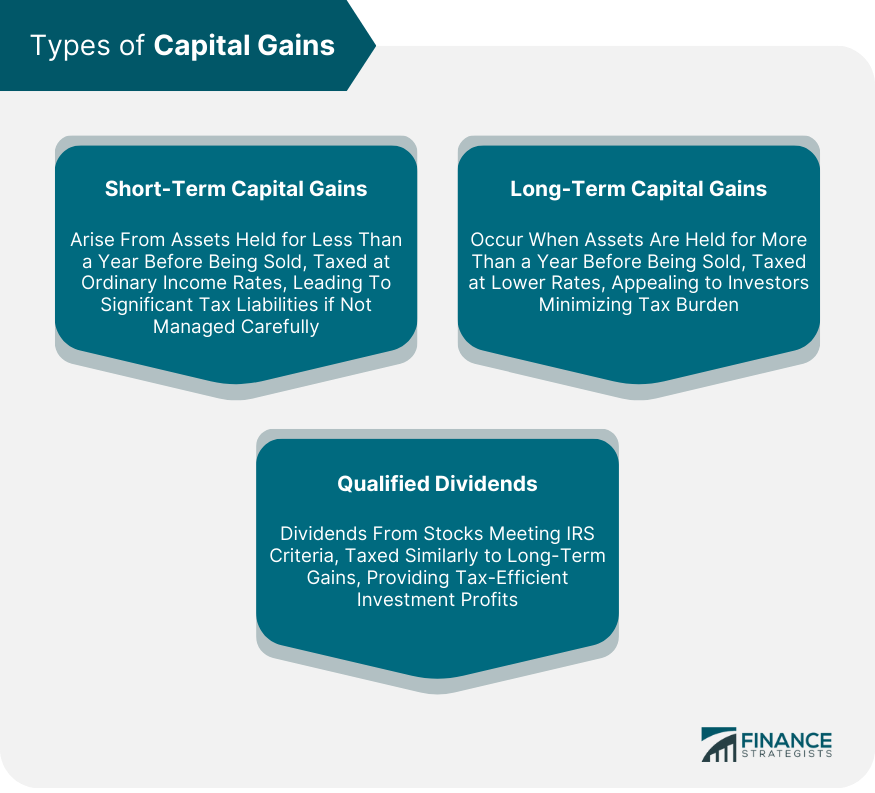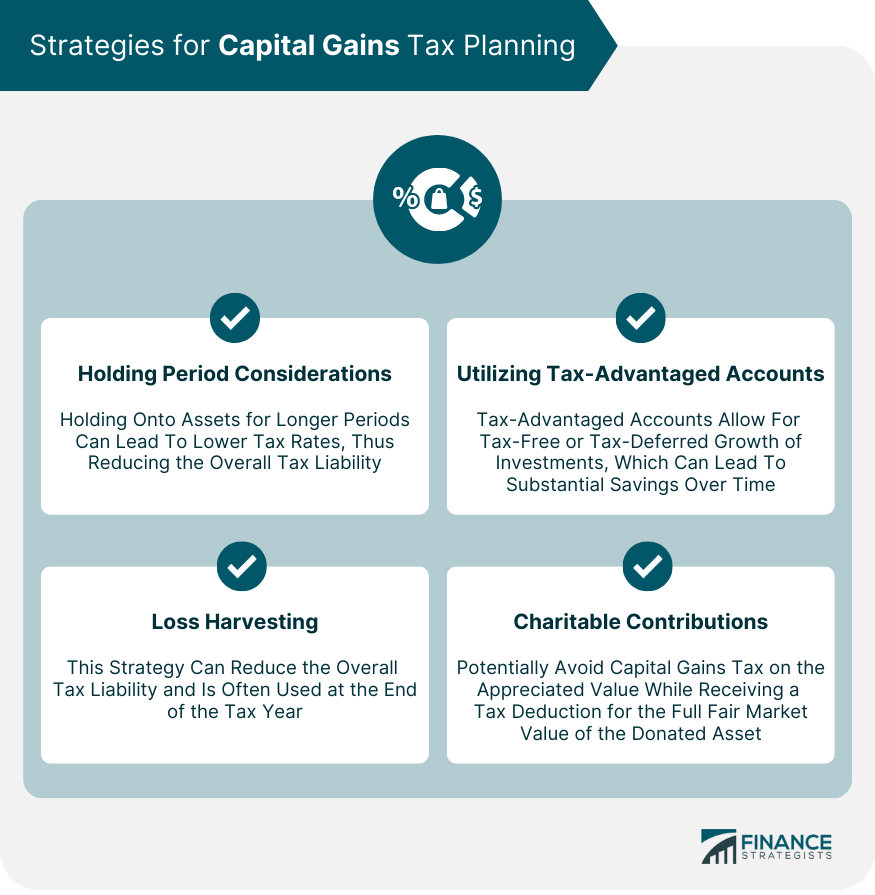Capital gains refer to the increase in value of an asset or investment over time. When you sell an asset for more than you initially paid for it, the resulting profit is termed as a capital gain. This profit, realized when the asset is sold, could be from investments such as stocks, real estate, or a business. However, a capital gain only becomes real or is "realized" when the asset is sold. If the asset has appreciated in value but still remains in the owner's possession, the gain is "unrealized" and is not subject to taxation. In many jurisdictions, capital gains are subject to tax, known as capital gains tax, which is levied on the profit made from selling the asset. The rate of taxation can depend on several factors, including the type of asset, the duration the asset was held, and the taxpayer's income bracket. Short-term capital gains arise when assets are held for a short duration, typically less than a year, before being sold. This type of gain is usually taxed at ordinary income tax rates, which can be quite high depending on the individual's tax bracket. For this reason, short-term trading can lead to significant tax liabilities if not carefully managed. Long-term capital gains occur when an asset is held for more than a year before being sold. Investors are particularly attracted to the comparatively lower tax rates for long-term gains as opposed to short-term gains. By holding onto an asset for the long term, investors can potentially realize significant profits while minimizing their tax burden. Qualified dividends are another type of capital gain, albeit with a slightly different character. These are dividends received from stocks that meet specific criteria outlined by the Internal Revenue Service (IRS). They are generally taxed at the same rates as long-term capital gains, making them another tax-efficient method of realizing investment profits. The cost basis is a critical factor in determining capital gains as it represents the original value of an asset for tax purposes. The cost basis includes the purchase price of the asset, plus any additional costs related to its acquisition, like commissions or improvements in the case of real estate. The capital gain is then calculated by subtracting the cost basis from the sale price of the asset. Sometimes, the cost basis of an asset needs to be adjusted due to specific events, such as stock splits, dividends, or capital improvements in the case of real estate. Adjustments can increase or decrease the cost basis, thus affecting the size of the realized capital gain or loss. Accurate record-keeping is crucial to correctly adjust the basis and calculate the capital gain or loss. The process of netting capital gains and losses involves offsetting gains from the sale of one asset with losses from another. This strategy can effectively reduce the amount of taxable income. However, certain rules apply to this process, including limitations on the amount of loss that can be deducted in a single year. Short-term capital gains are typically subject to ordinary income tax rates. The rate of tax applied to these gains varies depending on the individual's tax bracket, which in turn depends on their overall taxable income. Higher-income individuals will generally face higher tax rates on their short-term capital gains. Long-term capital gains enjoy preferential tax treatment in many jurisdictions. These gains, resulting from the sale of assets held for more than a year, are often taxed at lower rates than ordinary income. The rate applied can vary depending on the type of asset and the taxpayer's income level but is typically less than the rate applied to short-term gains. In the United States, a Medicare surtax, also known as the Net Investment Income Tax (NIIT), is applied at a rate of 3.8% on the lesser of net investment income or the amount by which modified adjusted gross income exceeds certain thresholds. This surtax affects higher-income individuals and can increase the overall tax burden on capital gains. The holding period of an asset, or the time duration for which an asset is held before being sold, can significantly affect the tax rate applied to any resulting capital gains. Generally, holding onto assets for longer periods can lead to lower tax rates, thus reducing the overall tax liability. Tax-advantaged accounts like Individual Retirement Accounts (IRAs) or 401(k)s in the United States can be a valuable tool for managing capital gains. These accounts allow for tax-free or tax-deferred growth of investments, which can lead to substantial savings over time. However, there are often rules and restrictions on contributions and withdrawals that investors should be aware of. Loss harvesting is a strategy that involves selling securities at a loss to offset capital gains from other investments. This strategy can reduce the overall tax liability and is often used at the end of the tax year. However, investors should be mindful of the 'wash-sale' rule, which disallows the claim of a loss if the same or substantially identical security is purchased within 30 days before or after the sale. By donating appreciated securities, investors can potentially avoid capital gains tax on the appreciated value, while also receiving a tax deduction for the full fair market value of the donated asset. However, specific rules and limitations apply to charitable deductions, so it's crucial to consult with a tax advisor before making such contributions. Real estate can have unique implications for capital gains tax. Specific rules apply to the sale of primary residences, rental properties, and investment real estate. Certain strategies, like utilizing the home sale tax exclusion or doing a 1031 exchange on investment property, can potentially reduce or eliminate capital gains tax. The sale of stocks and bonds can result in capital gains or losses. Tax rates can vary depending on the holding period and the type of security sold. Additionally, some bonds, like municipal bonds, offer tax advantages that can be beneficial for investors in higher tax brackets. Mutual funds are a common investment vehicle that can generate capital gains and losses. It's essential to be aware that even if an investor doesn't sell their mutual fund shares, they can still incur a tax liability if the fund sells securities resulting in a capital gain. Capital gains from the sale of collectibles, such as art, antiques, or rare coins, are typically subject to higher tax rates than other types of assets. It's important for collectors to keep accurate records of acquisition and selling prices to correctly calculate their capital gains. When selling business assets, owners may realize a capital gain or loss. The tax implications can be complex and are affected by factors like the type of asset sold, how long the asset was held, and the business's legal structure. Tax planning can help minimize tax liabilities and maximize after-tax proceeds from the sale. Stock options and Employee Stock Purchase Plans (ESPPs) provide opportunities for employees to acquire company shares, often at a discounted price. However, these plans can have complex tax implications, including potential capital gains when the shares are sold. Business succession planning often involves the transfer of business ownership, which can result in substantial capital gains. However, with careful planning, business owners can implement strategies to minimize taxes and ensure a smooth transition of the business to the next generation. In the United States, capital gains and losses are reported to the IRS using Form 8949 and Schedule D. These forms require detailed information about each capital transaction, including dates of acquisition and sale, cost basis, and sale proceeds. Proper completion of these forms is critical for tax compliance. Different types of assets may have unique reporting requirements. For example, the sale of real estate may require additional forms or schedules, and certain transactions may need to be reported even if they do not result in a capital gain. Maintaining accurate records is crucial for reporting capital gains and losses correctly. Records should include documentation of purchase and sale prices, dates of transactions, and any related expenses or adjustments. Proper record-keeping can help ensure tax compliance and make the process of preparing tax returns easier and more accurate. Capital gains refer to the profit that comes from selling an asset or an investment for more than the price at which it was originally purchased. These gains, though initially exciting due to the associated profit, bear significant tax implications, hence requiring careful planning and consideration. Capital gains can be derived from various sources like real estate, stocks, bonds, mutual funds, and businesses. Proactive planning for capital gains tax is crucial in any financial strategy. The rules governing capital gains are intricate, with different types of assets and holding periods often subject to different tax rates. By implementing tax planning strategies such as considering the holding period, utilizing tax-advantaged accounts, harvesting losses, and making charitable contributions, individuals and businesses can potentially reduce their tax liability.What Are Capital Gains?
Types of Capital Gains
Short-Term Capital Gains
Long-Term Capital Gains
Qualified Dividends

Determining Capital Gains
Cost Basis Calculation
Adjustments to Basis
Netting Capital Gains and Losses
Tax Rates on Capital Gains
Ordinary Income Tax Rates
Special Rates for Long-Term Capital Gains
Medicare Surtax
Strategies for Capital Gains Tax Planning
Holding Period Considerations
Utilizing Tax-Advantaged Accounts
Loss Harvesting
Charitable Contributions

Tax Planning Considerations for Specific Assets
Real Estate
Stocks and Bonds
Mutual Funds
Collectibles
Capital Gains Tax Planning for Business Owners
Sale of Business Assets
Stock Options and Employee Stock Purchase Plans
Business Succession Planning
Reporting and Compliance
Form 8949 and Schedule D
Reporting Requirements for Different Types of Assets
Keeping Accurate Records
Conclusion
Capital Gains FAQs
Capital gains refer to the profit made when an asset or investment is sold for more than its purchase price.
Short-term capital gains arise from the sale of assets held for less than a year, while long-term capital gains are from the sale of assets held for more than a year. They are taxed at different rates.
The cost basis is the original value of an asset for tax purposes, including the purchase price and any additional costs related to its acquisition. Capital gains are calculated by subtracting the cost basis from the sale price of the asset.
Strategies include holding onto assets for longer periods to qualify for lower long-term capital gains tax rates, utilizing tax-advantaged accounts, netting capital gains and losses, and making charitable contributions of appreciated assets.
In the United States, capital gains and losses are reported to the IRS using Form 8949 and Schedule D. Different types of assets may have unique reporting requirements, and maintaining accurate records is crucial for compliance.
True Tamplin is a published author, public speaker, CEO of UpDigital, and founder of Finance Strategists.
True is a Certified Educator in Personal Finance (CEPF®), author of The Handy Financial Ratios Guide, a member of the Society for Advancing Business Editing and Writing, contributes to his financial education site, Finance Strategists, and has spoken to various financial communities such as the CFA Institute, as well as university students like his Alma mater, Biola University, where he received a bachelor of science in business and data analytics.
To learn more about True, visit his personal website or view his author profiles on Amazon, Nasdaq and Forbes.











